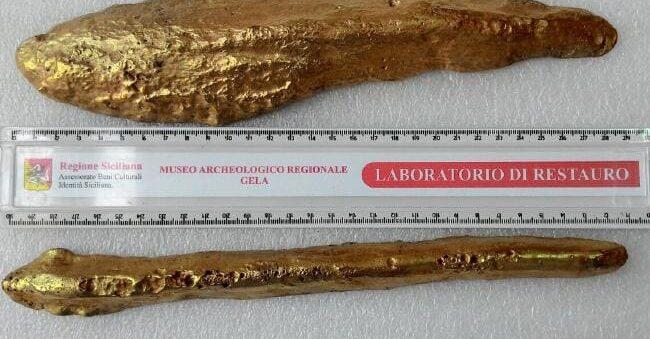
The name orichalucum derives from the Greek word oreikhalkos, literally meaning “mountain copper” or “copper mountain”. According to Plato’s 5 th century BC Critias dialogue, orichalucum was considered second only to gold in value, and was found and mined in many parts of the legendary Atlantis in ancient times.
Plato wrote that , the three outer walls of the Temple to Poseidon and Cleito on Atlantis were clad respectively with brass, tin, and the third, which encompassed the whole citadel, “flashed with the red light of orichalcum”.
Orichalcum is also mentioned in the ‘Antiquities of the Jews’ (1 st century AD) – Book VIII, sect. 88 by Josephus, who stated that the vessels in the Temple of Solomon were made of orichalcum (or a bronze that was like gold in beauty).
Off the coast of Sicily, near the city of Gela, a new expedition to a 2,600-year-old shipwreck has returned with 47 lumps of orichalcum, a rare alloy said to be smelted* on the fabled island of Atlantis, Seeker reports.
The shipwreck dates back to 600 B.C. and was previously explored in 2015, when underwater archaeologists found 39 ingots of the metal. This trip also yielded a jar and two Corinthian helmets.
orichalcum was supposed to be a shiny alloy, much like brass. It’s known from ancient texts, like Plato, which described it as a rare metal, mined at Atlantis. Plato described a temple to Poseidon that had an entire pillar of orichalcum, Seeker says. LucasArts fans of a certain age may remember it as a feature of the computer game Indiana Jones and the Fate of Atlantis.
In 2015, after this shipwreck was discovered, Sicilian officials started describing the metal found there by the same name. The ingots were made from zinc, charcoal and copper, News Corp Australia reported at the time; tradition had it that orichalcum was made of copper, gold and silver. The metal found by the shipwreck, though, matched ancient descriptions of orichalcum, which was supposed to have a red tone to it.
Whether or not the metal found in this particular shipwreck is the orichalcum of old, it is a strange and rare discovery—possibly sent to the sea as an offering to the gods.
http://www.atlasobscura.com/articles/found-47-lumps-of-orichalcum-an-ancient-alloy-attributed-to-atlantis
"In 2015, a number of ingots believed to be orichalcum were discovered in a sunken vessel (in the coasts of Gela in Sicily), which has tentatively been dated as being 2600 years old. Analyzed with X-ray fluorescence by Dario Panetta, of TQ - Technologies for Quality, the 39 ingots turned out to be an alloy consisting of 75-80 percent copper, 15-20 percent zinc, and smaller percentages of nickel, lead and iron."
https://en.wikipedia.org/wiki/orichalcum
Looks like a type of bronze.
https://en.wikipedia.org/wiki/Bronze
Brass usually has some zinc.
https://en.wikipedia.org/wiki/Brass
According to a Daily Telegraph report, the ingots have been analyzed and found to be made of about 75-80 percent copper, 14-20 percent zinc and a scattering of nickel, lead, and iron.
The name orichalucum derives from the Greek word oreikhalkos, meaning literally “mountain copper” or “copper mountain”. According to Plato’s 5th century BC Critias dialogue, orichalucum was considered second only to gold in value, and was found and mined in many parts of the legendary Atlantis in ancient times. https://archaeology-world.com/orichalcum-the-lost-metal-of-atlantis-may-have-been-found-on-a-shipwreck-off-sicily/
ANCIENT SICILIAN SHIPWRECK CARRYING ATLANTIS-LINKED METAL TO BE RECOVERED
Nearly 45 years after its discovery, an ancient shipwreck off the coast of Sicily is finally being recovered. The Gella II, a 5th century BC Greek vessel found near the historic port of Gela, has fascinated archaeologists for decades due to its remarkably preserved state and mysterious cargo.
Resting 1,000 feet below sea level, the wreck has revealed valuable clues about ancient Greek trade, shipbuilding, and seafaring. Between 2015 and 2017, divers recovered 86 ingots of orichalcum, a rare golden alloy linked by ancient writers to the lost city of Atlantis.
Orichalcum, meaning “mountain copper” in Greek, was described by Plato as highly prized, second only to gold. It was said to decorate the outermost wall of the Temple of Poseidon in Atlantis.
In addition to orichalcum, past excavations uncovered Corinthian helmets, amphorae, metal objects and personal items.
Now, in 2025, the Sicilian Superintendence of the Sea has secured €500,000 to excavate and recover the shipwreck, in collaboration with local cultural organisations.
This rare glimpse into the ancient world is about to surface at last.
Uncover incredible historic locations and artefacts in your area using the ARCHI UK database at www.archiuk.com
Discover hidden histories with ease! Subscribe to ARCHI UK on YouTube for exclusive tips on mastering old maps and LiDAR technology! www.youtube.com/@archiuk
See Also
